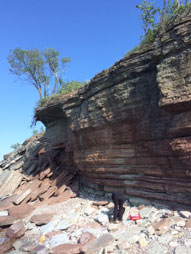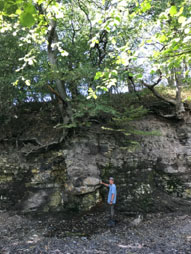Field Excursions
Pre-conference field excursion to Öland

A pre-conference field trip to the Swedish island of Öland in the Baltic Sea is planned. Öland is a classic place to visit and gives the name to the regional Oelandian Series. The trip will inspect the Cambrian–mid Ordovician platform deposits typical of the Baltoscandian region. This excursion will show the delegates the well-exposed Cambrian – Middle Ordovician succession on the island. The visit starts with the Cambrian siliciclastic and interbedded shale-limestone deposits (Alum Shale Formation) and continue with the Lower Ordovician strata composed of siliciclastic and carbonaceous glauconite dominated deposits (Tremadocian). These beds represent the transition into the famous condensed platform limestone deposition (known as the “orthoceratite limestone”; Floian to upper Darriwilian). The carbonates accumulated both in shallow- and deep-water setting starting with the Floian green-grey limestone and concluding in the upper Darriwilian red limestone. The deposits are among the best Ordovician representatives for cool water carbonate deposition and renowned for the high content of fossils (cephalopods and trilobites, some graptolites, among the microfossils are acritarchs, chitinozoans and conodonts well represented). The succession also displays the prominent changes in sealevel and palaeoclimate. The plan is to visit both the northern and southern parts of the island.
Duration: 3 days.
Max. number of participants: 20 people
Excursion Leader: Svend Stouge
Mid-conference field excursion to Scania, Sweden

A mid-conference field trip to the southernmost province of Sweden (Scania) is planned. This area is in close proximity to Copenhagen and we will visit a handful well exposed and classic localities illustrating the lower Palaeozoic succession of the southern margin of the Baltoscandian plate. Delegates will have the opportunity to study early Cambrian sandstone with abundant trace fossils and sedimentary structures representing tidal- to storm-dominated shallow-marine environments (Hardeberga Sandstone Formation and Læså Formation), parts of the middle Cambrian through Early Ordovician Alum Shale Formation in an area where it reaches its maximum thickness, the GSSP for the base of the Sandbian Stage and associated shale and phosphorite beds at Sandby outside Lund, and the Dapingian–Darriwilian orthoceratite limestone (Komstad Limestone). Depending on time and interest there may be possibilities to also see Late Silurian shale and fossiliferous limestone.
Duration: 1 day
Max. number of participants: All delegates
Excursion Leader: Mikael Calner
Post-conference field excursion to Bornholm

A post-excursion field trip to the Danish island of Bornholm in the Baltic Sea is planned. Focus will be on the predominantly siliciclastic lower Palaeozoic succession exposed along rivers and in quarries on the southern part of the island. The Cambrian succession reflects the globally rising sea level with transgression followed by deposition in progressively deeper shelf environments. The Ordovician is strongly condensed, partly as a result of deposition in an outer shelf setting far from the clastic source and partly as a result of local uplift in the Bornholm area. The Silurian is much expanded, being deposited in a deep foreland basin. Only the lower 170 m of the succession is preserved onshore Bornholm; the Silurian was probably some 3 km thick originally.
Duration: 2 days
Max. number of participants: 50 persons
Excursion Leader: Arne T. Nielsen
